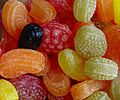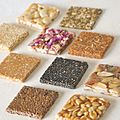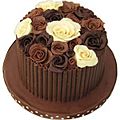Candy facts for kids
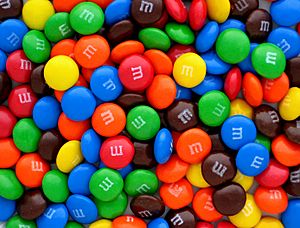
Candy is a sweet food often made from sugar and water. It usually has added flavors and other ingredients. The word candy comes from the Persian word for "cane sugar." It might also come from the Sanskrit word khanda, meaning "piece of sugar."
You can find candy in almost any store, as many companies make it. Some people also make candy at home. Most people enjoy candy because it tastes good. However, candy has a lot of sugar, so it is not very healthy to eat too much. It's best to enjoy it sometimes as a treat. Candy is a very common snack, and there are hundreds of different flavors, shapes, and sizes.
Candy is also known as sweets or lollies. It is a type of confection where sugar is the main ingredient. This group of foods, called sugar confectionery, includes sweet treats like chocolate, chewing gum, and sugar candy. When fruits, vegetables, or nuts are covered with a sugar glaze, they are called candied.
Candy is special because it uses a lot of sugar or sugar substitutes. Unlike a cake or a loaf of bread that is shared, candies are usually small, single pieces. How people see candy also depends on their culture. For example, sweet pastries are often served as dessert after a meal. But candies are usually eaten casually, often with fingers, as a snack between meals. What is considered candy in one culture might be a dessert in another.
Contents
The Story of Candy
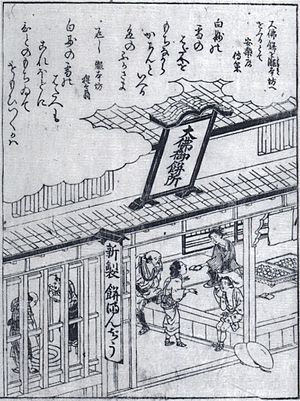
The word "candy" came into the English language from an old French term, çucre candi, which meant "sugar candy." This French term likely came from older words in Arabic, Persian, and Sanskrit, all meaning sugar.
Sugarcane first grew in warm parts of South and Southeast Asia. People in ancient India made pieces of sugar by boiling sugarcane juice. They called this khanda. Between 600 and 400 BCE, the Persians and then the Greeks learned about India's "reeds that produce honey without bees." They then helped spread sugar and sugarcane farming.
Before sugar was easy to find, candy was made with honey. In Ancient China, the Middle East, Egypt, Greece, and the Roman Empire, honey was used to cover fruits and flowers. This helped preserve them or turn them into candy. Today, this type of candy is still made, but it's often used as a decoration on other foods.
Before the Industrial Revolution, candy was sometimes seen as a type of medicine. People used it to help with an upset stomach or a sore throat. In the Middle Ages, only the richest people had candy. It started as a mix of spices and sugar to help with digestion. Hosts at fancy parties would offer these "candies" to their guests. One such candy, called chamber spice, was made with cloves, ginger, aniseed, juniper berries, almonds, and pine kernels dipped in melted sugar.
The word candy began to be used in English in the late 1200s.
The first candy arrived in America in the early 1700s from Britain and France. Only a few early settlers knew how to work with sugar. So, sugary treats were mostly enjoyed by very wealthy people. Even simple rock candy, made from crystallized sugar, was a luxury.
Candy for Everyone
The candy business changed a lot in the 1830s. New technology and more sugar became available, opening up the market. Candy was no longer just for the rich; working-class people could also enjoy it. There was also a growing market for children. While some fancy candy makers remained, the candy store became a favorite spot for children of American working families.
"Penny candies" showed this change best. They were the first items children could buy with their own money. Because of this, candy store owners relied almost entirely on children's business. Even penny candies came from medicated lozenges that held bitter medicine inside a hard sugar coating.
In 1847, the invention of the candy press (also called a "toy machine") made it possible to create many shapes and sizes of candy at once. In 1851, candy makers started using a spinning steam pan to help boil sugar. This meant they no longer had to stir the boiling sugar all the time. The heat from the pan was also spread more evenly, making it less likely for the sugar to burn. These new ideas made it possible for just one or two people to run a candy business successfully.
As candy production grew, some foods were affected by additives. These additions ranged from harmless ingredients like cheap cornstarch to unsafe ones. Some manufacturers used dangerous substances to make bright colors in candy. For example, green could come from chromium or copper, red from lead or mercury, and yellow from lead. There were no laws to stop this.
In 1885, a cartoon in Puck magazine by Joseph Keppler showed the dangers of candy additives. It showed a "mutual friendship" between striped candy, doctors, and gravediggers, hinting at the health risks. By 1906, research, news reports, and public pressure led to the Pure Food and Drug Act. This was the first federal law in the United States to control food and drugs, including candy.
How Candy is Made
Candy is made by dissolving sugar in water or milk to create a syrup. This syrup is then boiled until it reaches a certain thickness or starts to caramelize. Candy comes in many different textures, from soft and chewy to hard and crunchy. The texture depends on the ingredients and the temperatures used during the making process.
Most candies are made in factories. The candy industry relies a lot on trade secrets. This is because candy recipes cannot easily be protected by copyright or patent. Even small differences in the machines, temperature, or timing can change the final candy a lot.
Candy and Your Health
Candy is generally not a major source of nutrition or energy for most people.
Candy usually contains sugar, which is a main cause of dental caries (cavities). Several types of bacteria in your mouth, especially Streptococcus mutans, eat sugar. When these bacteria break down the sugar from candy or other sugary foods, they create acids. These acids can wear away your tooth enamel, leading to cavities.
Eating a lot of sugary foods often, especially lollipops or cough drops that stay in your mouth for a long time, increases the risk of tooth decay. Candies that also have acids, like acid drops, increase this risk even more. Brushing your teeth and cleaning your mouth soon after eating sugary foods can help. Also, waiting a few hours between eating such foods reduces the risk and improves your oral health.
Good Things About Some Candies
Some candies, mainly those with peppermint and mint, can help your digestion. Peppermint oil can calm an upset stomach and may help with irritable bowel syndrome. It can also fight germs.
Chewing mint-flavored gum can improve short-term memory and increase oxygen in the brain. This link between heart rate and brain oxygen helps with memory. Chewing gum can also cause a small release of insulin, preparing your body for food.
When eaten in small amounts, dark chocolate can have health benefits. The cocoa in dark chocolate may help lower the risk of heart disease. Dark chocolate also contains vitamins and minerals like calcium, magnesium, and sodium, as well as antioxidants.
Images for kids
-
Karl Fazer (1866–1932) started the successful Fazer company in the 1890s, which focused on candy and confectionery.
-
Licorice is a candy flavored with extract from the licorice plant roots. It is popular in Finland.
-
Butterscotch candies, each wrapped individually.
-
Halloween candy for sale at a supermarket in Virginia.
-
Konpeitō is a traditional Japanese sugar candy. It is almost 100% solid sugar when finished.
-
Fruit-shaped hard candy is a common type of sugar candy. It contains sugar, color, flavor, and a little water.
-
Chikki are homemade nut brittles popular in India. They have hard sugar candy between the nuts or seeds.
-
German Haribo gummy bears were the first gummi candy ever made. They are soft and chewy.
-
Fudge is a type of sugar candy made by mixing and heating sugar, butter, and milk.
-
Unsweetened baking chocolate has no sugar.
-
Bittersweet or dark chocolate contains some sugar.
-
Milk chocolate contains milk and less cocoa.
-
Because white chocolate has no cocoa solids, it is called sugar confectionery instead of chocolate.
-
Compound chocolate is used instead of pure chocolate to save money.
-
These flowers were made from modeling chocolate.
See also
 In Spanish: Caramelo (golosina) para niños
In Spanish: Caramelo (golosina) para niños













